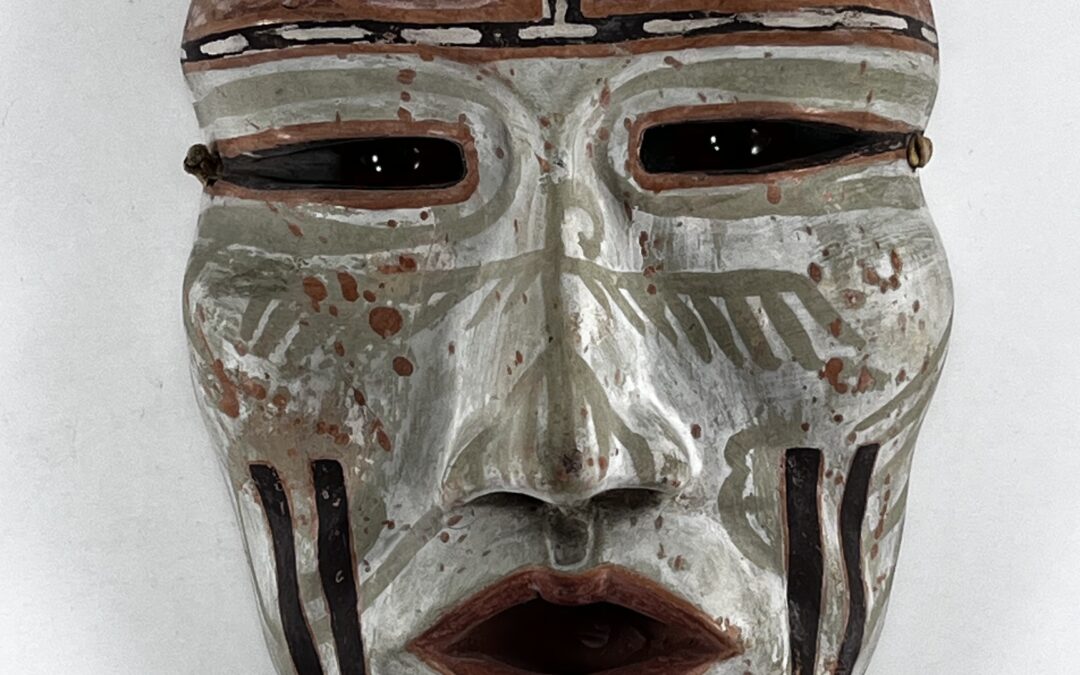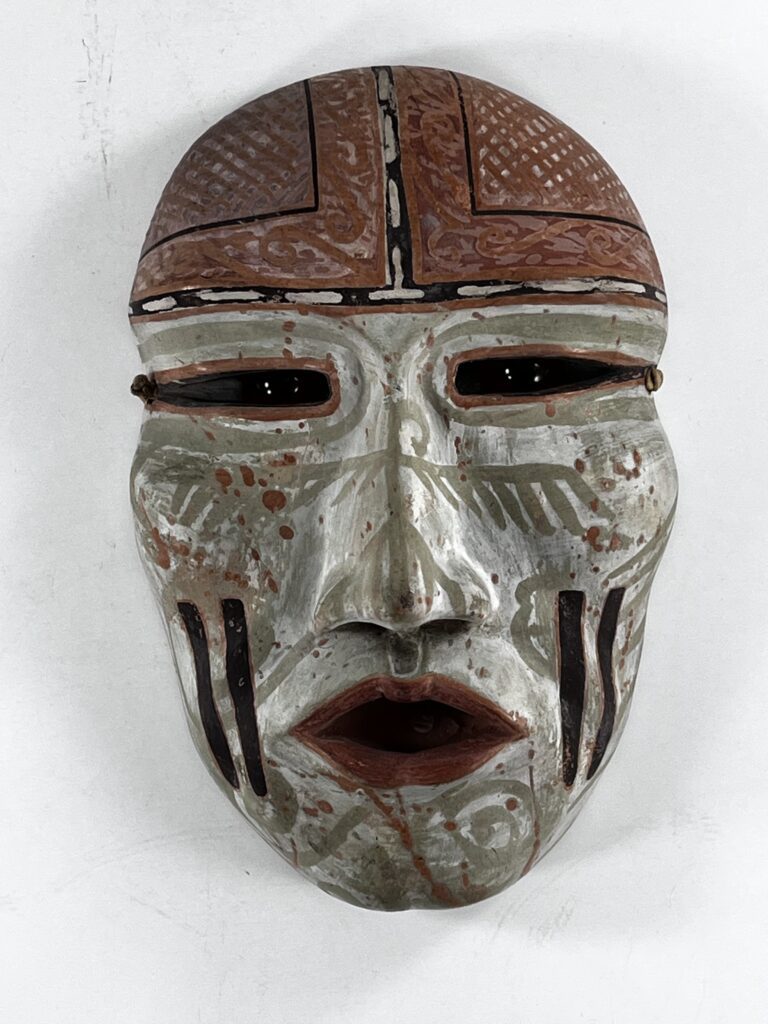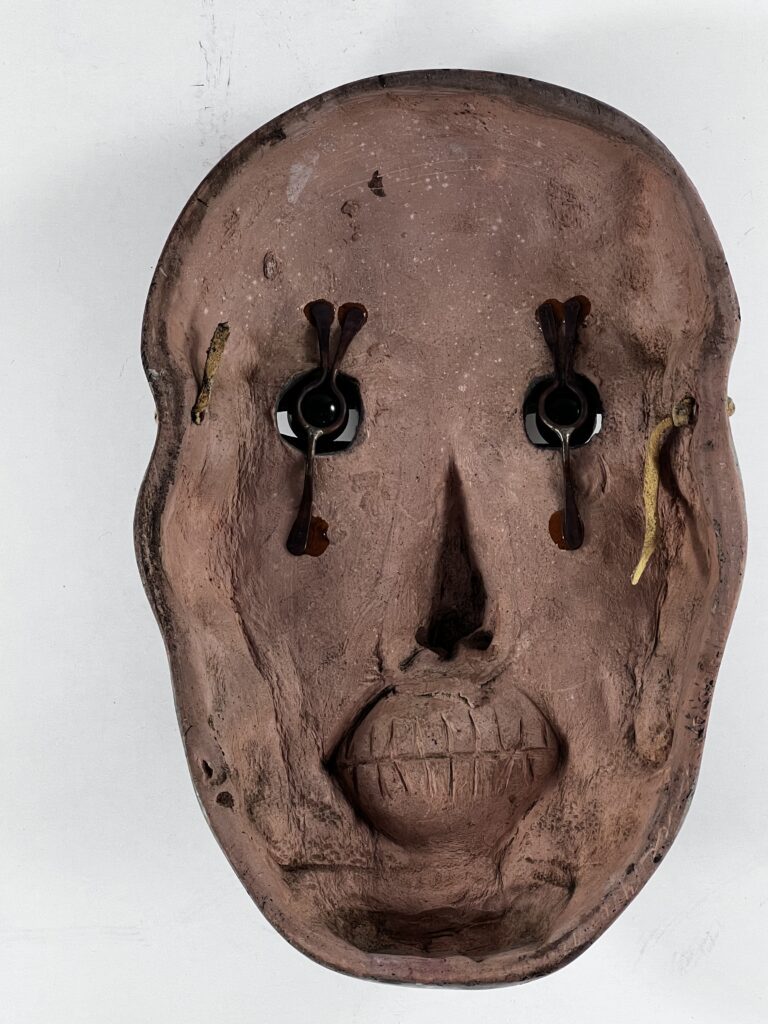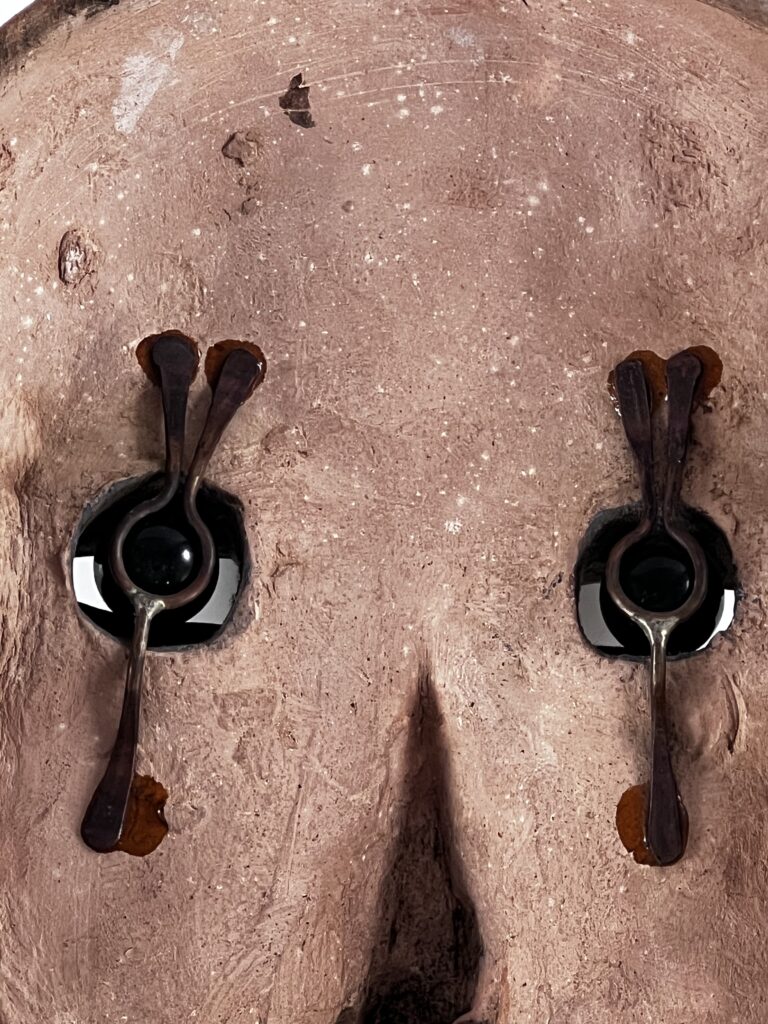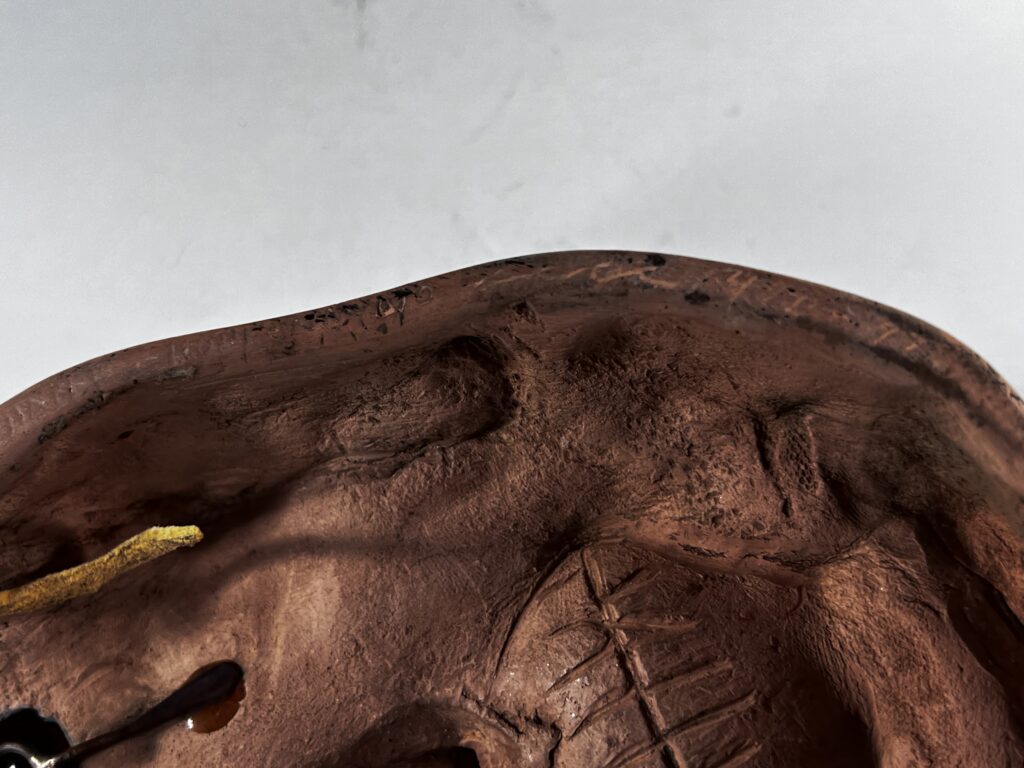This is a face carrying a complex history. I see this man as a mystic wounded warrior, my impressions of him mixed. On the one hand he has a strong visage with a layered iconography. He carries a lot of painful history in those marking. On the other hand, his inset eyes and open mouth communicate directly to me in an honest, intimate, and vulnerable conversation indicated by the muted colors of the visage. Strong, direct, intimate and muted: it’s a good mix of characteristics to have in a friend. I look forward to our conversations.
Form:
The shape of the mask exhibits great detail, some of it more recognizable by touch than sight.
The forehead occupies the top 30% of the face and is without features. Its lower edge is marked by raised eyebrows over each eye, separated by a small flat area directly above the nose. Each eyebrow is taller toward the center of the head and flattens as it reaches the edge of the mask.
The two eyes occupy their own isolated space, surrounded on three sides by the higher eyebrows, nose and cheeks. Within this space, the eyelids are slightly raised. The eyes are 2.0-inches long and are cut into the surface of the face 0.25-inches deep. They are torpedo-shaped: a rounded blunt edge near the nose and narrowing to a point near the edge of the face. Then things get complicated. From the rear of the mask Nathan cut a 0.75-inch round hole in the center of each eye. Since the eye was already 0.25-inches below the surface of the face, this 0.75-inch wide hole is also below the face’s surface. To understand how Nathan finished the eyes, you need to look at the rear of the mask. Glued to the rear of the mask over the eye opening are two metal fixtures cradling 0.5-inch wide black spheres. Light does not shine through these balls, so I am guessing they are onyx rather than glass. In short, from the front the eyes are complex: sunken torpedo shapes with a large dilated black pupils suspended in an open space.
The 2-inch long nose rises like a ramp from between the two eyebrows. The nose was embossed by pressing out the clay from the rear. The point of the nose is rounded and is flanked by the nostrils, each having an exterior arched curve and a wide open interior that emerges at the rear of the mask. Flanking the nose below the eyes are raised and rounded cheeks.
The lips are open and frame a mouth 1-inch deep. From the rear the mouth forms an oval mound. Curiously Nathan has engraved the surface of this mound with two rows of 9 teeth. The front of the mouth is framed by lips rendered in great detail. The lips rise above the surface of the mask like triangular ridges. The upper lip carries a small protrusion at its mid-point. The bottom lip displays a dimple at its mid-point.
On either side of the mouth there are 1.5-inch long vertical ridges of clay that, as we will see below, occupy the space between two black warrior stripes. Below the mouth is a prominent chin with a cleft at its center.
Written almost imperceptibly on the lower left edge of he mask is “Nathan B, Hopi Navajo, his cloud cypher, and 4-1-97,” the date of production.
Design:
Charles King is an authority on pueblo pottery and was a friend of Nathan Begaye. Speaking of a pot by Nathan for sale in his gallery, Charles wrote:
“For many of his pieces, he would talk about them being ‘layered,’ much like his own cultural and personal experiences. That is often the best way to look at these pieces and extract something from each of the varied layers….. Looking through all the layers, the jar becomes a fascinating balance of color, form, design, and contrasting shapes.”
Seeing mask 2023-02 as having a layered design offers the clearest understanding of this complex face.
Unlike most pueblo pottery, the intensity of the colors of the design on mask 2023-02 vary. There are three levels of intensity, from subtle to emphatic. I believe the mask was initially covered in two colors.
Subtle color: The lower 70% of the mask has a base layer of darker grey. The entire mask was then covered with a top layer of thin, watered-down, white color.
More emphatic color: Midway in intensity are the surfaces of the mask painted siena ochre (RGB color #DE9F83), most noticeably the base layer of the mask’s forehead.
Most emphatic color: The most emphatic color on the mask is black. A small amount of dense white paint is also used in the design. Both these colors are used sparingly on the mask.
I do not know how the unusual designs on this mask were created, but I speculate the following process. I believe that a base color of siena ochre was applied to the forehead while a darker grey color was used as a base color below the forehead. I think that the entire mask was then covered with an upper layer of watered-down, thin white paint. Most of the designs were then created by using a solvent (water? alcohol?) on a brush to remove the top layer of thin white paint, creating pattern and revealing the background color below.
Black paint was used to segregate the forehead into four areas. A thick horizontal line runs from one edge of the mask to the other across the eyebrows. At its mid point a thick vertical line rises to the upper edge of the mask, forming an inverted “T” shape, thus cutting the forehead in half. Nine horizontal and five vertical white dashes are drawn on these black lines. On either side of the bifurcated forehead a thin black line is drawn 0.625-inches from the horizontal and vertical lines of the inverted black T. The result is a 0.625-inch wide “L” shape sandwiched between the thick and thin black lines.
The right such L (viewer’s perspective) features thin, unadorned siena ochre lines just to the right of and parallel to the thin black lines that define its shape. So thin is this line that it can easily be overlooked.This detail will have some significance when we analyze the mask’s design, below. The left residual L lacks this ochre line.
The interior spaces of the two “L” elements are densely-covered with curlicue doodles and some linear shapes in no particular pattern. This pattern is difficult to see because a) one expects to see painted elements rather than elements formed by removing the covering of thin white paint leaving only irregular fragments of watered-down white color against the ochre background, and b) the fragmented residual white paint is so light that it is difficult to see.These markings can best be seen by rotating the mask in a bright light that reflects off the design.
The two L elements cradle residual wedges, the outer edge of the wedges being the curve of the head. Both wedges are crisscrossed by a matrix of 13 by 13 siena ochre lines created by removing the top thin-white color. The space between these lines is irregular, leaving a pattern of residual light white squares of varying sizes.
The base color of the lower 70% of the mask is a darker grey. The top layer is the same watered-down white color we saw on the forehead. Again I think Nathan used a brush dipped in some solvent to remove the top whitish layer, revealing the darker grey below, and creating pattern. Thus the majority of the designs on the lower 70% of the face appear darker grey. Because they are of a similar color, the grey designs and whitish-grey background tend to visually blend.
Around the eyes the top white surface has been removed, leaving a thick framing line of darker grey. On either side of the nose are casually-drawn linear forms that look somewhat like the end of a rake. When looking at the mask a 3.5-inch stack of slanted, parallel, lines marks the right cheek of the face. A curlicue graces the bridge of the nose. More curlicues cover the chin and left cheek. These linear and curvilinear grey designs are not patterned, but seem to be spaced randomly, as if doodles floating in space.
The most emphatic design on the face is the set of thick 2-inch long, black stripes on each cheek that bracket the raised ridge mentioned above.
Siena ochre covers the wide expanse of the forehead, but it is also used as an eyeliner and lip gloss. Notice that siena ochre also edges the warrior stripes. Splatters of this ochre also cover the cheeks and chin of the warrior.
Design Analysis:
In spite of its subtle markings, the design on mask 2023-02 grabs the eye. The complex structure of the eyes is arresting and creates a dark, unsettling and penetrating stare. The open siena mouth provides a second focus for the mask. The two black stripes on each cheek are so dramatic that they immediately attract the viewer’s eyes, a third focus. The cheek stripes, perhaps scarification, paint this man as “warrior” ready for battle. As did Nampeyo, color is used to unify the design. Sienna ochre is the base color above eyebrows, some facial features and random splatters of color on other surfaces of the face. Notice that the warrior stripes are carefully edged with this color. Assuming I am correct about Nathan’s painting technique, the using of a solvent to remove the thin, white, top color results in design elements that are indistinct. This is particularly true on the forehead which is filled with barely discernible curlicue doodles, but also true on the rest of the face where we find light grey elements with fuzzy edges blending into a pale white background.
Yet there are a few examples of exceptionally careful painting on the mask. One is that the thin, almost invisible, sienna ochre line bordering the thick black L-shaped line on the right side of the forehead. The exactly-drawn thin L-shaped black lines on both sides of the forehead are a second example. Finally the thin sienna ochre lines that border the four black warrior stripes on the cheeks are a third instance of careful drawing on the mask. These examples of careful-drawn elements do not add much to the design, but they are evidence that Nathan was fully able to exactly control his brush when decorating the mask.
The key to understanding this warrior mask is the contrast between the careful, realistic form of the face and the deliberately-indistinct designs.
This collection contains another example of contrast between form and design by Nathan. Bowl 2015-02 is crudely-formed but carries a carefully-painted design. On the bowl the contrast between form and design exsses Nathan’s aesthetic intention. On mask 2023-02 Nathan carefully formed a beautiful male face and then painted it with casual, indistinct designs. The question is why?
The form and design of the mask represent different ways of being, identities that are in conflict, and for this warrior the source of existential despair. This despair is most clearly seen in the mask’s elaborately-constructed, haunting, eyes, for “eyes are windows to the soul.” As it is written:
“The eye is the lamp of the body. So, if your eye is sound, your whole body will be full of light; but if your eye is not sound, your whole body will be full of darkness. If then the light in you is darkness, how great is the darkness! No one can serve two masters; for either he will hate the one and love the other, or he will be devoted to the one and despise the other. You cannot serve God and mammon (Matthew 6:22-24).”
A warrior is exactly that, one soul required to serve two masters. War is antagonistic to civilian values. This warrior portrays the psychological devastation of that conflict.
The mask’s perfect facial form is that of a model civilian, law-abiding and probably a good neighbor. The forehead covers a brain full of painful memory. The casual, ghost-like, linear and curlicue design elements on the forehead and face of the mask are the faded memories of a lifetime of battles, emerging randomly in a dream-like state, but continuing to have presence . His face is splattered with siena ochre, the blood of his profession; his warrior stripes are edged with the same color. His face is marked by a detritus of memory .
The tension between his civilian and military identities is catastrophic, an existential crisis.*** Which person should he be? This warrior is not a silent witness to war and despair, but bravely speaks of his pain through that open mouth.
I speculate that the aesthetic of this mask was born in Nathan’s difficult childhood and his later struggles with his sexual identity and addictions. One has to warrior oneself to take on such pain. Without minimizing the difficulties of Nathan’s life, it is also true that we all have our history of hurts and love and pain and bravery, so the art of this face has meaning that resonates with me. Other viewers will bring their own histories to this mask and find different meaning. Art is dialogue, and conversation with this warrior is a rich one.
***For an extraordinary discussion of the psychological impact of war on solders, see Johnathan Shay, Achilles in Vietnam: Combat Trauma and the Undoing Of Character, New York, Touchstone Publishing (1994).

